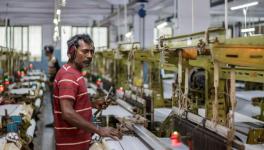More Than Half of Construction Workers in Surat Are Homeless

Image Courtesy: The Peninsula Qatar
More than half the workers serving the daily wage labour market for construction in Surat in Gujarat are forced to live in the open with their families as they cannot afford rental housing, says a study by Prayas Centre for Labour Research and Action (PCLRA), which works among the unorganised sector.
The report is based on a survey undertaken in December 2018 on the living and working conditions of migrant construction workers in the city of Surat, one of commercial hubs in Gujarat.
Malliben, a 35-year-old kadia majur (construction worker), has been coming to Surat for the past 15 years. She, along with her husband Vinodbhai, has worked in the construction industry in Surat for the past decade and a half.
In a conversation with her, she shares that living in a city like Surat is a constant fight for survival. Hailing from Radiyatibura in Dahod district of Gujarat, Malliben has through the years witnessed how the skyline of the city has transformed. She has probably worked on many of the recently built buildings, housing societies and other construction and infrastructure projects. And while the city has progressed, grown, and prospered, she and her husband have resided on the same footpath at Majura Gate, where they came for the first time in 2003.
A seasonal migrant, she arrived as young and newly married bride, accompanying her husband to support her family to a city far away from home. Today, Malliben stands weathered, with her children grown enough to take care of themselves and studying back in the village. She states that while the city has grown and changed, some things remain the same.
For instance, she still faces harassment on a regular basis at the hands of the municipal authorities. They live under the constant threat of theft by the lorry drivers who pass Majura Gate, a busy intersection, late at night; these lorry drivers have often robbed her and other migrant workers sleeping on the footpath. The fear of theft has forced her (and also others) to leave behind her identity documents. This further entails harassment by the police.
Although she has been coming from the village to Surat for more than a decade, she still remains an outsider — a seasonal, migrant, construction worker who comes from the tribal regions of Gujarat.
Also read: Kerala Shows the Way By Embracing Migrant Workers
Malliben and her husband are part of the pool of 120 million people who are estimated to seasonally migrate from rural areas to urban labour markets, industries and farms of the relatively prosperous western states like Gujarat.
Chinmay Tumbe in his book India Moving: A history of migration (2018), while tracing various routes undertaken for migration historically, indicates that 70% of Surat’s workforce consists of inter-state migrants. This workforce that arrives in Surat gets absorbed in the booming sectors of textile and construction and infrastructure. The workers arrive either through contractors to work at pre-assigned sites or through kin alliances, who help them find work.
To deepen the understanding of the socio-economic reality of this floating population in the prospering city such as Surat, the PCLRA conducted the study titled ‘They Leave Their Homes to Build Ours’, sponsored by the Rosa Luxemberg Stiftung.
The study maps the working and living conditions of migrant construction workers in Surat. This study mapped about 6,300 workers, their families, the conditions in which they find work, reside, and access various public services and entitlements as people who contribute to the economic growth of the city. The study spearheaded by Indira Hirway extends itself to also form an understanding about the aspirations of the workers, along with a grounded understanding of reasons for migration, the impact of labour laws, and to comprehend the critical relationship between migration and development. As the title of the report informs the reader, the report particularly emphasizes on the deplorable living conditions of the workers in addition to their harsh working conditions.
The study mapped 1,869 families across 30 worker settlements across Surat to document the conditions of facilities and amenities the workers live in.
The study shows that although 50% of the 1,869 families mapped across 30 bastis have spent up to five years or more working as migrants in the city, very few have been able to afford any rented accommodation.
Fifty six per cent of workers reported living in open areas such as footpaths, under flyovers, bridges, open plots and grounds or slums (implying that such spaces will inherently not have any basic amenities, due to their untenable nature).
Considering that the workers who arrive in Surat undertake family migration, it often becomes difficult for the migrants to find accommodation which would be suitable for their family. Like Malliben, many workers are forced to live on footpaths in order to be able to save enough money that could be remitted to their homes instead of spending it on rented accommodation in a city like Surat.
Lack of residence also means that the workers have no identity documents in spite of having spent considerable amount of time working and building the city. Like our respondent, many workers are forced to leave behind their identity documents back in the source village for the fear of loss or theft of such documents.
This organically entails that the migrant workers are left outside the purview of the benefits that are linked with the proof of documents certifying domicility.
Vulnerability of the workers is further aggravated by a high incidence of non-payment of wages. Seventy three per cent of 3,415 workers mapped at nakas reported that they had faced at least one incident where they had been denied their wages. Loss of wages, the need to remit income back home, incur various expenses ranging from medical expenses, to social events such marriage, death, birth rituals, and investment into agricultural activities (for those who have land) — all this leaves them with less disposable income that can be used to rent an accommodation.
Also read: Symbolic Justice is All the Unorganised Sector Can Hope For
The study details how many migrant workers migrate to the city in their youth in search of relatively better economic opportunities. About 60% of the workers mapped in the study belonged to the age group of 19 to 30 years.
Malliben and Vinodbhai are two names in the swarm of workers who arrive every season to cities to economically secure their households. The workers, as the study documents, arrive in significant numbers from a contiguous region in North East Gujarat spread across three states — Gujarat, Rajasthan, and Madhya Pradesh.
They come either through contactors who directly place them on construction project sites or through their kin-ties who help them find work at labour stands or nakas.
To understand these differentiated spaces that workers use to find themselves work, the study mapped 3,415 workers across 15 labour stands (and 1,869 families residing in 30 worker settlements, as mentioned earlier). Additionally, the study also sought to have an extended mapping of 200 workers and their families across private and public construction sites.
These seemingly different spaces of accessing workers helped the research team corroborate and triangulate certain characteristics of the migrant construction workforce. This brought forth characteristics about the workforce such as that around 70 per cent of the 3,415 workers mapped at the nakas were tribal workers, followed closely by the people who identify themselves as OBC (16% of 3,415 workers).
Of the total 3,415 respondents, 69% found work as unskilled labourers, while 30% worked as karigars or skilled workers. Intuitively, a majority of these workers who have remained outside the formal education system (45% of the 3,415 workers reported as illiterate) are absorbed as unskilled workers in the sector.
Under-representation of Women in Study Sample
What stands out in the entire mapping exercise is the low number of women respondents. An observation that the study makes is that despite visible presence of women workers — at the nakas, bastis, and construction sites — who can be found mainly performing unskilled tasks such as head loading, women mostly refrained from responding to the survey questions.
The report foregrounds the issue of under-representation of women in the sample. For instance, there were only 10% of the total 3,415 workers mapped at nakas who were women, while there were only seven female respondents among the 200 sample.
The author of the report elaborates how focus group discussions with the female workers were organised so that their perspective could be incorporated into the study. What came forth was a peculiar response, that women felt that responses by men represented their concerns as well and hence did not feel the need to share their concerns separately.
This tendency of under-representation of women strikingly comes forth when women refrain from registering themselves with the Board for Construction and Other Building Workers Welfare Board (BOCW, hereafter referred to just as Board). They explained that if one member of the family is already registered with the board, what was the need for women of the same family to register?
Construction sector is one of the only sectors in the country that has a board instituted to look after the welfare of its registered members. One observes through the report that while the number of the registered workers remains low (98% of total workers remain unregistered), the number of registered women workers was even lower.
Of the total sample of 3,415 workers, only three women were registered with the Board and were, hence, entitled to the benefits that accrue to them as construction workers.
Of course, a high rate of workers outside the board membership also entails that they remain outside the access to the schemes and benefits enlisted for them in the board.
Also read: Bihar Migrants Workers Forced to Return After Holi, Give LS Polls a Miss
One may ask what limits the workers from registering themselves with the Board that collects cess from all the construction projects.
The respondents discussed that extensive paperwork and time-consuming process are two among many factors that keep workers from registering themselves with Board.
The report most importantly foregrounds the irony that the migrant workers employed in construction and infrastructure face every day.
The sector is structurally inadequate to implement various legal provisions that apply to the migrant workers, nor is there political will for the concerned stakeholders to work towards improving living and working conditions of the workers.
Lack of domicility documents also warrants that they do not form part of the eminent vote bank within the city. The state, non-state, private actors are so far removed from the workers who lay the foundation of the booming sectors, such as construction sector, that the plight of workers remains invisible to the various stakeholders of these sectors.
As the title of the report rightly suggests, these workers leave their homes to build ours in cities like Surat, but they continue to live without a home themselves.
(The writer works with Prayas Centre for Labour Research and Action as Coordinator for Research and Documentation. The views are personal)
Get the latest reports & analysis with people's perspective on Protests, movements & deep analytical videos, discussions of the current affairs in your Telegram app. Subscribe to NewsClick's Telegram channel & get Real-Time updates on stories, as they get published on our website.
























